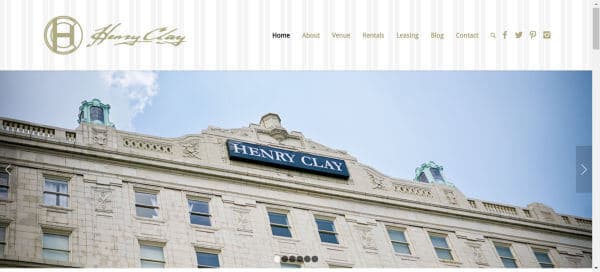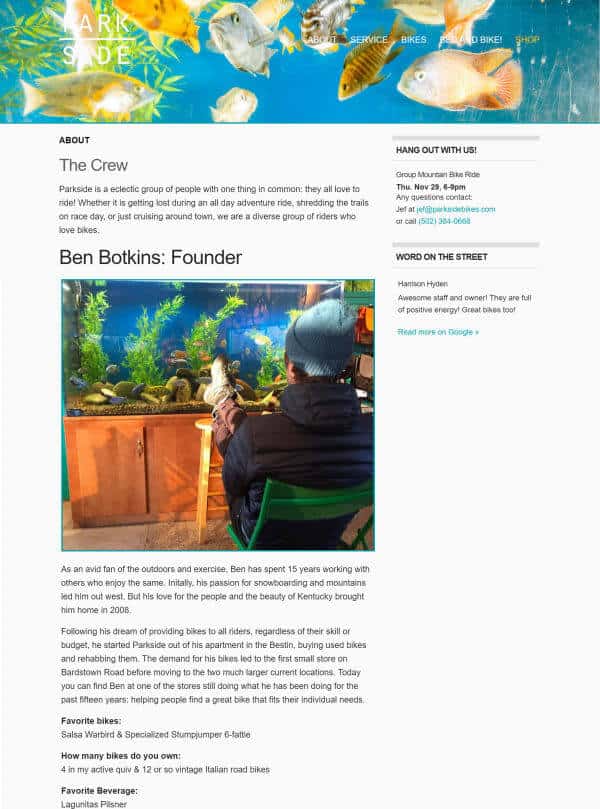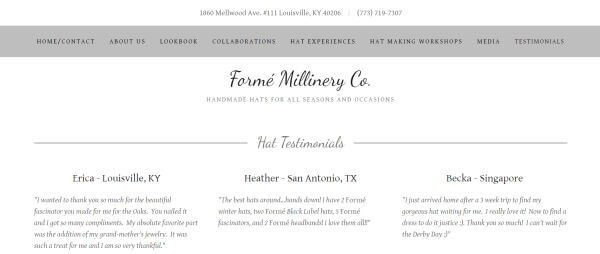But have no fear!
The internet today is full of great examples of websites that found creative and innovative ways to attract potential customers, engage and inspire action from site visitors, and set themselves apart from competitors.
We have compiled a list of nine small business websites in the Louisville, KY area that did just that. When looking at these element examples, be sure you are not directly copying them. Instead, use them as inspiration and customize them to fit your marketing and website needs.
1. The Henry Clay: Killer Homepage

Originally built in 1924, The Henry Clay has become a popular venue in the heart of downtown Louisville to host a variety of events, from weddings to corporate events. They made our list because their homepage hits all the top elements that make it a killer homepage. Simple navigation, list of services, and an easy to understand call-to-action allow visitors to quickly find what they are looking for. In addition, they highlight the recognition they received from three of the top wedding sites and utilize a blog section to keep visitors up-to-date on events and news. When they combine all this with a clean layout and simple color scheme, they produce a stunning display to highlight their business that is sure to bring in new customers.
2. Crafts Gallery & Mercantile: Service Descriptions

Crafts Gallery & Mercantile is a Contemporary and Traditional Art Gallery providing the Ohio River Valley with design presentations, fine art consulting, sales, picture hanging, art installations, and customized corporate art programs. Their excellent descriptions of their services are how they got a spot on this list. They describe what they do, how their process works and the benefit and value the customer can gain from their services. Having this type of content builds trust and enhances the customer experience by making your site more appealing.
3. Park Side Bikes: Employee Bios

Born in 2009, Parkside Bikes was Louisville’s first used bike store. Its creation was built on the hope that anyone could walk into the store and find their perfect bike. With any local store, it’s important to establish a strong relationship between the customers and the employees. Parkside Bikes did a great job of introducing their founder and staff on their website. They included original photos of their employees and brief bios about everyone. This allows people to emotionally invest in a relationship with your small business before stepping foot inside your doors.
4. Logic Media: “You Statement” and Call-to-Action

Logic Media has been providing web design and marketing solutions to the Louisville Metro area since 2003. Their excellent “You Statement” and Call-to-Action is what helped land them a spot on this list. As soon as their website pops onto your screen, visitors instantly know what services they provide and how those services can benefit their business. Their Call-to-Action is very clear and lets visitors know that if they want to grow their business with digital marketing to generate revenue, then the next step is to click on the button to get a complimentary consult. When you combine a “You Statement” with a clear CTA, your website stands a great chance of increasing conversions, thus making your business profitable.
5. 3 Space: Video about a Product/Service

Educating your customers is an excellent way to build trust and establish your business as an authority in your industry. 3 Space is a company that does industrial 3D printing and they created an interactive video to educate potential customers about their 3D scanning services. This is a creative way to show potential customers who may not be familiar with the ins and outs of 3D scanning an in-depth look into the process and how they can benefit from this service. When you educate visitors, you help them make an informed purchasing decision and build a positive business-customer relationship.
6. Tim R. Winters Architect: “How It Works” Page

Founded in 1988, Tim R. Winters Architect was built to fill the lacking niche of residential architect in the Louisville, Ky area. They specialize in timeless and classic designs inspired by the early 1900s. Their clear and easy to understand description of their service process is an excellent example of a “How It Works” page. They section the process out step by step, mention what people will be a part of each step, and what everyone’s, including the client’s, responsibilities are. This shows they are taking the necessary actions to make sure the client knows what to expect at each stage of the design process, and ensures that the client gets the most out of the process. Well done, Tim R. Winters Architect!
7. Formé Millinery Co.: Testimonial Page

The Formé Millinery Co. is a custom hat shop and a unique gem for the city of Louisville. Their website made our list because of the different and beneficial way they organized their testimonials. While many companies just list their testimonials on a page on their site, Formé Millinery Co. broke up their testimonials based on the categories of “hat testimonials,” “experience testimonials,” and “hat making workshop testimonials.” This breakdown is a great way to show visitors, who are leery of this industry because of how unique it is, current and previous customers’ experiences with different aspects of this business. Testimonials and reviews are essential to any large or small business, because of the growing popularity of consumers wanting social proof before making a purchase.
8. Abrams Roofing & Sheet Metal Inc.: Original Images

It’s a tried and true fact that using original images on your website is the best option versus using stock images. Original images consist of photographs, infographics, cartoon, GIFs, or any other visual element that are used to further promote your brand. Abrams Roofing & Sheet Metal Inc. is a great example of a business using their personal photographs to enhance the user experience and build trust among the site’s visitors. The picture of an old work truck with the company logo on it instantly builds an emotional attachment between the company and the customer. It proves they have been in business since the 1950s, they have won the trust of their customers, and will continue to carry on the company’s values.
9. Great Flood Brewing Co.: Product and Process Description

The Great Flood Brewing Company is a Louisville native bar that opened its doors in 2014 and began its own beer production in 2017. What makes this brewing company stand out from the rest is their impressive description of their brewery and how their beer is created. They talk about how different ingredients affect the taste of the beer, the many tools that are used at each stage of the production, and the journey from grain to beer. Creating this type of content has the potential to improve conversions, because it allows them to connect with and educate the reader. This also builds trust and relationships because they are giving the information needed to make an informed buying decision.
NOW IT’S YOUR TURN!
After looking at all of these amazing examples, what did you discover? When executed correctly, each element has the chance to increase the quantity and quality of the user experience.
What happens when you increase the quantity and quality of the user experience? You stand the chance of creating better leads and increasing the number of conversions. Who doesn’t want that!?
Your website is the digital face your company and it needs to promote your brand in a positive way. With the help of these killer content elements, you can create a website that helps your small business stand out from the competition, make an impression, build relationships, and gain more customers.
The post 9 Tips To Boost Your Small Business Website appeared first on Onethingmarketing.net
One Thing Marketing
2305 Hurstbourne Village Drive #400
Louisville, KY 40299
502-532-1818
https://www.onethingmarketing.net/map/
https://www.onethingmarketing.net/info/
The post 9 Tips To Boost Your Small Business Website appeared first on Onethingmarketing.net
One Thing Marketing
2305 Hurstbourne Village Drive #400
Louisville, KY 40299
502-532-1818
https://www.onethingmarketing.net/map/
https://www.onethingmarketing.net/info/











 Across the world wide web, there are hundreds of directory sites that Charlie’s business name, address, and phone number could appear on. We’ve narrowed down the list to the most prominent directories, as well as picked out a few niche directories for Charlie’s business. To ensure that each listing is correct, our local search expert will do each of the following:
Across the world wide web, there are hundreds of directory sites that Charlie’s business name, address, and phone number could appear on. We’ve narrowed down the list to the most prominent directories, as well as picked out a few niche directories for Charlie’s business. To ensure that each listing is correct, our local search expert will do each of the following:
















